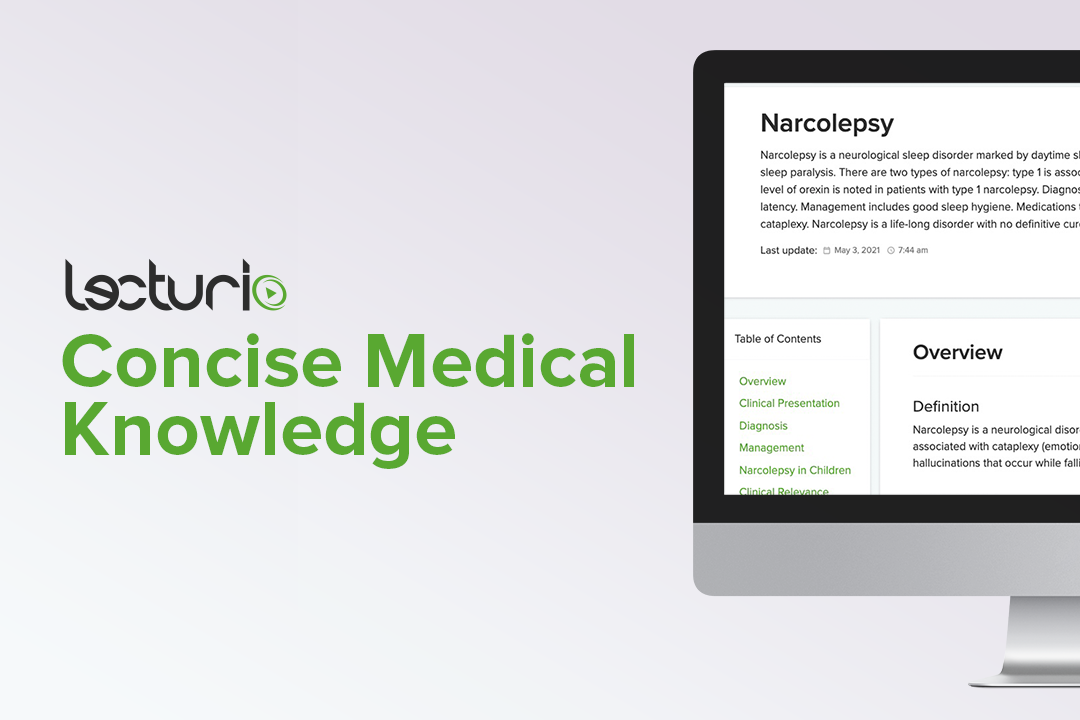Playlist
Show Playlist
Hide Playlist
Introduction to Narcolepsy
-
Slides Sleep Disorders Narcolepsy.pdf
-
Download Lecture Overview
00:00 So let's talk about narcolepsy. Let's review a definition of what it is, talk a little bit about the pathophysiology, how we diagnose and manage these patients. First, let's start with a definition. Narcolepsy is a sleep disorder marked by daytime sleepiness and it is associated with 3 important clinical episodes. The first is cataplexy. These are emotionally triggered loss of muscle tone. As a result of a startle, a loud noise, or something that startles the patient, the patient will lose muscle tone and may drop all the way to the floor. The second is hypnagogic hallucinations. We remember that hypnagogic hallucinations are hallucinations when patients are going to sleep and we can see auditory or tactile hallucinations that occur right when the patient is falling asleep. These are differentiated from hypnopompic hallucinations which occur upon awakening. And then last is sleep paralysis. This is very disconcerting for patients, a brief period of immobility, inability to move upon awakening. Patients wake up, they're fully conscious but they are unable to move their body and this typically last for short minutes, after which tone resolves and patients are able to move normally. When we classify narcolepsy, we can classify it as narcolepsy type 1, type 2, and secondary narcolepsy and this will be important in terms of our diagnostic investigations. Where does narcolepsy come from? What causes it? Well, there are a number of brainstem structures that are involved in getting us to go to sleep and maintaining sleep and making sure we're awake and not asleep during the day. 01:47 When we think about those important brain structures, we start with the lateral hypothalamus. This produces orexin which is an important wakefulness promoting hormone and substance in the brain. The lateral hypothalamus speaks to the tuberomammillary nucleus which sends descending projections to the raphe nuclei and the locus coeruleus which in turn send projections to the multiple neurotransmitter systems to turn the brain on and promote wakefulness. So in this way, we see that the hypothalamus and brainstem controls our level of arousal. 02:24 In narcolepsy, loss of neurons in that lateral hypothalamus is the primary cause of narcolepsy type 1. And this will be important in diagnosing these patients, we'll look at orexin levels and see a reduction in the orexin levels that is diagnostic of narcolepsy type 1. Abnormalities in this system also contribute to narcolepsy type 2 and secondary causes of narcolepsy. When we think about narcolepsy type 1, there are both genetic and environmental factors that contribute to this condition. 02:58 Genetic factors include certain forms that are familial and in particular mutations in the DQB1 gene. 96% of patients with this haplotype will also have orexin deficiency and so in narcolepsy type 1 we see orexin levels are low and this is contributing to the symptoms and syndrome in this patient. There are also environmental triggers, neurons that produce orexin, maybe destroyed due to an autoimmune process triggered after strep infection or a strep pharyngitis or certain types of flu and could trigger the development of narcolepsy type 1. In terms of narcolepsy type 2 and secondary narcolepsy, in narcolepsy type 2 orexin levels are normal. There is dysfunction in that circuit, the inability to maintain wakefulness but it does not result from a reduction or degeneration or attack on orexin- producing neurons in the hypothalamus and the etiology is poorly understood. 03:56 There are also secondary causes of narcolepsy where there is an underlying lesion. 04:01 We think about things like tumors, strokes, vascular malformations, inflammatory processes such as sarcoidosis which can cause a basal meningeal irritation and this also may be associated with various genetic syndrome such as Prader-Willi syndrome. And here, we see loss of that posterior hypothalamus function and midbrain circuitry.
About the Lecture
The lecture Introduction to Narcolepsy by Roy Strowd, MD is from the course Sleep Disorders.
Included Quiz Questions
What is narcolepsy?
- A neurological sleep disorder marked by daytime sleepiness and associated with cataplexy, hypnagogic hallucinations, and sleep paralysis
- A group of sleep disorders marked by unusual actions, activities, or physiological events that occur during sleep or sleep–wake transitions
- A group of conditions characterized by recurrent patterns of sleep disruption
- A sleep disorder characterized by difficulty in initiation, maintenance, or consolidation of sleep, leading to an impairment in function
- A degenerative neurologic disease marked by pronounced insomnia
Which of the following terms describes the emotionally triggered loss of muscle tone?
- Cataplexy
- Hypnagogic hallucinations
- Sleep paralysis
- Catatonia
- Narcolepsy
What type of narcolepsy is characterized by genetic factors, loss of neurons in the lateral hypothalamus, and orexin (hypocretin) deficiency?
- Narcolepsy type 1
- Narcolepsy type 2
- Secondary narcolepsy
- Cataplexy
- Hypnagogic narcolepsy
What is hypothesized to be a possible trigger of an autoimmune process causing narcolepsy?
- Streptococcal pharyngitis
- Alcoholism
- Yersinia enterocolitica
- Smoking
- Cocaine use
Lesions affecting which region of the brain might lead to secondary narcolepsy?
- Posterior hypothalamus
- Ventromedial hypothalamus
- Basal ganglia
- Dorsolateral prefrontal cortex
- Internal capsule
Customer reviews
5,0 of 5 stars
| 5 Stars |
|
5 |
| 4 Stars |
|
0 |
| 3 Stars |
|
0 |
| 2 Stars |
|
0 |
| 1 Star |
|
0 |




